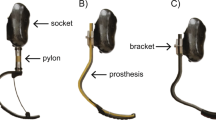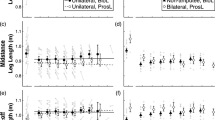Abstract
Purpose
we determined the metabolic and biomechanical effects of adding mass to the running-specific prosthesis (RSP) and biological foot of individuals with a unilateral transtibial amputation (TTA) during running.
Methods
10 individuals (8 males, 2 females) with a TTA ran on a force-measuring treadmill at 2.5 m/s with 100 g and 300 g added to their RSP alone or to their RSP and biological foot while we measured their metabolic rates and calculated peak vertical ground reaction force (vGRF), stance-average vGRF, and step time symmetry indices.
Results
for every 100 g added to the RSP alone, metabolic power increased by 0.86% (p = 0.007) and for every 100 g added to the RSP and biological foot, metabolic power increased by 1.74% (\(p<\) 0.001) during running. Adding mass had no effect on peak vGRF (p = 0.102), stance-average vGRF (p = 0.675), or step time (p = 0.413) symmetry indices. We also found that the swing time of the affected leg was shorter than the unaffected leg across conditions (\(p<\) 0.007).
Conclusions
adding mass to the lower limbs of runners with a TTA increased metabolic power by more than what has been reported for those without an amputation. We found no effect of added mass on biomechanical asymmetry, but the affected leg had consistently shorter swing times than the unaffected leg. This suggests that individuals with a TTA maintain asymmetries despite changes in RSP mass and that lightweight prostheses could improve performance by minimizing metabolic power without affecting asymmetry.



Similar content being viewed by others
Abbreviations
- RSP:
-
Running-specific prosthesis
- SI:
-
Symmetry index
- TTA:
-
Transtibial amputation
- vGRF:
-
Vertical ground reaction force
References
Alcantara R (2019) Dryft: a python and matlab package to correct drifting ground reaction force signals during treadmill running. J Open Source Softw 4(44):1910
Arellano CJ, Kram R (2014) Partitioning the metabolic cost of human running: a task-by-task approach. Integrat Compar Biol 54(6):1084–1098
Arellano CJ, McDermott WJ, Kram R, Grabowski AM (2015) Effect of running speed and leg prostheses on mediolateral foot placement and its variability. PLoS One 10(1):e0115637
Baum BS, Hobara H, Kim YH, Shim JK (2016) Amputee locomotion: ground reaction forces during submaximal running with running-specific prostheses. J Appl Biomech 32(3):287–294
Beck ON, Grabowski AM (2017) The biomechanics of the fastest sprinter with a unilateral transtibial amputation. J Appl Physiol 124(3):641–645
Beck ON, Taboga P, Grabowski AM (2017) Prosthetic model, but not stiffness or height, affects the metabolic cost of running for athletes with unilateral transtibial amputations. J Appl Physiol 123(1):38–48
Brockway J (1987) Derivation of formulae used to calculate energy expenditure in man. Human Nutr Clin Nutr 41(6):463–471
Brüggemann GP, Arampatzis A, Emrich F, Potthast W (2008) Biomechanics of double transtibial amputee sprinting using dedicated sprinting prostheses. Sports Technol 1(4–5):220–227
Claremont AD, Hall SJ (1988) Effects of extremity loading upon energy expenditure and running mechanics. Med Sci Sports Exerc 20(2):167–171
Clark KP, Ryan LJ, Weyand PG (2017) A general relationship links gait mechanics and running ground reaction forces. J Exp Biol 220(2):247–258
Daly C, McCarthy Persson U, Twycross-Lewis R, Woledge R, Morrissey D (2016) The biomechanics of running in athletes with previous hamstring injury: a case–control study. Scand J Med Sci Sports 26(4):413–420
De Leva P (1996) Adjustments to zatsiorsky-seluyanov’s segment inertia parameters. J Biomech 29(9):1223–1230
Divert C, Mornieux G, Freychat P, Baly L, Mayer F, Belli A (2008) Barefoot-shod running differences: shoe or mass effect? Int J Sports Med 29(06):512–518
Farley CT, McMahon TA (1992) Energetics of walking and running: insights from simulated reduced-gravity experiments. J Appl Physiol 73(6):2709–2712
Faul F, Erdfelder E, Lang AG, Buchner A (2007) G* power 3: a flexible statistical power analysis program for the social, behavioral, and biomedical sciences. Behav Res Methods 39(2):175–191
Franz JR, Wierzbinski CM, Kram R (2012) Metabolic cost of running barefoot versus shod: is lighter better? Med Sci Sports Exerc 44(8):1519–1525
Frederick E, Daniels J, Hayes J (1984) The effect of shoe weight on the aerobic demands of running. Urban & Schwarzenberg, Vienna
Fuller JT, Bellenger CR, Thewlis D, Tsiros MD, Buckley JD (2015) The effect of footwear on running performance and running economy in distance runners. Sports Med 45(3):411–422
Grabowski AM, McGowan CP, McDermott WJ, Beale MT, Kram R, Herr HM (2009) Running-specific prostheses limit ground-force during sprinting. Biol Lett 6(2):201–204
Herzog W, Nigg BM, Read LJ, Olsson E (1989) Asymmetries in ground reaction force patterns in normal human gait. Med Sci Sports Exerc 21(1):110–114
Hoogkamer W, Kipp S, Spiering BA, Kram R (2016) Altered running economy directly translates to altered distance-running performance. Med Sci Sports Exerc 48(11):2175–80
Innovations F (2014) Catapult running foot instructions for use. Freedom Innovations, Irvine
Jones BH, Toner MM, Daniels WL, Knapik JJ (1984) The energy cost and heart-rate response of trained and untrained subjects walking and running in shoes and boots. Ergonomics 27(8):895–902
Lloyd CH, Stanhope SJ, Davis IS, Royer TD (2010) Strength asymmetry and osteoarthritis risk factors in unilateral trans-tibial, amputee gait. Gait Posture 32(3):296–300
Martin PE (1985) Mechanical and physiological responses to lower extremity loading during running. Med Sci Sports Exerc 17(4):427–433
McGowan CP, Grabowski AM, McDermott WJ, Herr HM, Kram R (2012) Leg stiffness of sprinters using running-specific prostheses. J R Soc Interface 9(73):1975–1982
Modica JR, Kram R (2005) Metabolic energy and muscular activity required for leg swing in running. J Appl Physiol 98(6):2126–2131
Moed B, Kram R (2005) Metabolic costs of forward propulsion and leg swing at different running speeds. In: ISB XXth congress-ASB 29th annual meeting, Cleveland, OH
Myers M, Steudel K (1985) Effect of limb mass and its distribution on the energetic cost of running. J Exp Biol 116(1):363–373
Pinheiro J, Bates D, DebRoy S, Sarkar D (2018) R core team (2018). nlme: linear and nonlinear mixed effects models. r package version 3.1-137
R Core Team (2019) R: a language and environment for statistical computing. R Foundation for Statistical Computing, Vienna, Austria. https://www.R-project.org/
Royer TD, Martin PE (2005) Manipulations of leg mass and moment of inertia: effects on energy cost of walking. Med Sci Sports Exerc 37(4):649–656
Selles RW, Bussmann JB, Van Soest AK, Stam HJ (2004) The effect of prosthetic mass properties on the gait of transtibial amputees–a mathematical model. Disabil Rehabil 26(12):694–704
Smith JD, Martin PE (2013) Effects of prosthetic mass distribution on metabolic costs and walking symmetry. J Appl Biomech 29(3):317–328
Taylor CR, Heglund NC, McMAHON TA, Looney TR (1980) Energetic cost of generating muscular force during running: a comparison of large and small animals. J Exp Biol 86(1):9–18
Teunissen LP, Grabowski A, Kram R (2007) Effects of independently altering body weight and body mass on the metabolic cost of running. J Exp Biol 210(24):4418–4427
Wickham H (2016) ggplot2: elegant graphics for data analysis. Springer, New York. https://ggplot2.tidyverse.org
Funding
This study was supported by the University of Colorado Beverly Sears Graduate Student Grant.
Author information
Authors and Affiliations
Corresponding author
Ethics declarations
Conflict of interest
The authors declare that they have no conflict of interest.
Additional information
Communicated by Jean-René Lacour.
Publisher's Note
Springer Nature remains neutral with regard to jurisdictional claims in published maps and institutional affiliations.
Rights and permissions
About this article
Cite this article
Alcantara, R.S., Beck, O.N. & Grabowski, A.M. Added lower limb mass does not affect biomechanical asymmetry but increases metabolic power in runners with a unilateral transtibial amputation. Eur J Appl Physiol 120, 1449–1456 (2020). https://doi.org/10.1007/s00421-020-04367-9
Received:
Accepted:
Published:
Issue Date:
DOI: https://doi.org/10.1007/s00421-020-04367-9




